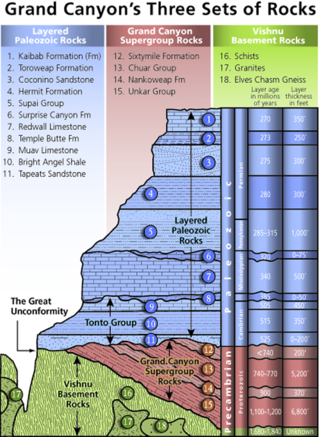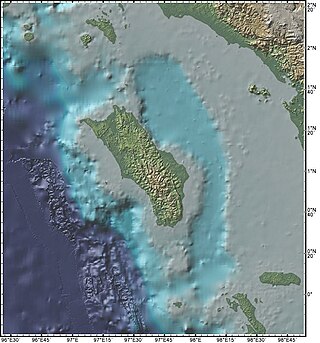
Sedimentary rocks are types of rock that are formed by the accumulation or deposition of mineral or organic particles at Earth's surface, followed by cementation. Sedimentation is the collective name for processes that cause these particles to settle in place. The particles that form a sedimentary rock are called sediment, and may be composed of geological detritus (minerals) or biological detritus. The geological detritus originated from weathering and erosion of existing rocks, or from the solidification of molten lava blobs erupted by volcanoes. The geological detritus is transported to the place of deposition by water, wind, ice or mass movement, which are called agents of denudation. Biological detritus was formed by bodies and parts of dead aquatic organisms, as well as their fecal mass, suspended in water and slowly piling up on the floor of water bodies. Sedimentation may also occur as dissolved minerals precipitate from water solution.

Sedimentary basins are region-scale depressions of the Earth's crust where subsidence has occurred and a thick sequence of sediments have accumulated to form a large three-dimensional body of sedimentary rock. They form when long-term subsidence creates a regional depression that provides accommodation space for accumulation of sediments. Over millions or tens or hundreds of millions of years the deposition of sediment, primarily gravity-driven transportation of water-borne eroded material, acts to fill the depression. As the sediments are buried, they are subject to increasing pressure and begin the processes of compaction and lithification that transform them into sedimentary rock.

The Los Angeles Basin is a sedimentary basin located in Southern California, in a region known as the Peninsular Ranges. The basin is also connected to an anomalous group of east-west trending chains of mountains collectively known as the Transverse Ranges. The present basin is a coastal lowland area, whose floor is marked by elongate low ridges and groups of hills that is located on the edge of the Pacific Plate. The Los Angeles Basin, along with the Santa Barbara Channel, the Ventura Basin, the San Fernando Valley, and the San Gabriel Basin, lies within the greater Southern California region. The majority of the jurisdictional land area of the city of Los Angeles physically lies within this basin.
The eustatic sea level is the distance from the center of the Earth to the sea surface. An increase of the eustatic sea level can be generated by decreasing glaciation, increasing spreading rates of the mid-ocean ridges or increasing the number of mid-oceanic ridges. Conversely, increasing glaciation, decreasing spreading rates or fewer mid-ocean ridges can lead to a fall in the eustatic sea level.
Sedimentary basin analysis is a geologic method by which the formation and evolution history of a sedimentary basin is revealed, by analyzing the sediment fill and subsidence. Subsidence of sedimentary basins generates the spatial distribution of accommodation infilling sediments. Aspects of the sediment, namely its composition, primary structures, and internal architecture, can be synthesized into a history of the basin fill. Such a synthesis can reveal how the basin formed, how the sediment fill was transported or precipitated, and reveal sources of the sediment fill. From such syntheses models can be developed to explain broad basin formation mechanisms. Examples of such basin classifications include intracratonic, rift, passive margin, strike-slip, forearc, backarc-marginal sea, fold and thrust belt, and foreland basins.

Of the many unconformities (gaps) observed in geological strata, the term Great Unconformity is frequently applied to either the unconformity observed by James Hutton in 1787 at Siccar Point in Scotland, or that observed by John Wesley Powell in the Grand Canyon in 1869. Both instances are exceptional examples of where the contacts between sedimentary strata and either sedimentary or crystalline strata of greatly different ages, origins, and structure represent periods of geologic time sufficiently long to raise great mountains and then erode them away.

A cratonic sequence in geology is a very large-scale lithostratigraphic sequence in the rock record that represents a complete cycle of marine transgression and regression on a craton over geologic time. They are geologic evidence of relative sea level rising and then falling, thereby depositing varying layers of sediment onto the craton, now expressed as sedimentary rock. Places such as the Grand Canyon are a good visual example of this process, demonstrating the changes between layers deposited over time as the ancient environment changed.
Cyclic sediments are sequences of sedimentary rocks that are characterised by repetitive patterns of different rock types (strata) or facies within the sequence. Processes that generate sedimentary cyclicity can be either autocyclic or allocyclic, and can result in piles of sedimentary cycles hundreds or even thousands of metres thick. The study of sequence stratigraphy was developed from controversies over the causes of cyclic sedimentation.
Stratigraphic cycles refer to the transgressive and regressive sequences bounded by unconformities in the stratigraphic record on the cratons. These cycles represent a large scale eustasy cycle since the Cambrian period with further sub-divisions of those units.
The Cheshire Basin is a late Palaeozoic and Mesozoic sedimentary basin extending under most of the county of Cheshire in northwest England. It extends northwards into the Manchester area and south into Shropshire. The basin possesses something of the character of a half-graben as its deepest extent is along its eastern and southeastern margins, where it is well defined by a series of sub-parallel faults, most important of which is the Red Rock Fault. These faults divide the basin from the older Carboniferous rocks of the Peak District and the North Staffordshire Coalfield.
The Messinian Erosional Crisis is a phase in the Messinian evolution of the central Mediterranean basin resulting from major drawdown of the Mediterranean seawater.

Growth faults are syndepositional or syn-sedimentary extensional faults that initiate and evolve at the margins of continental plates. They extend parallel to passive margins that have high sediment supply. Their fault plane dips mostly toward the basin and has long-term continuous displacement. Figure one shows a growth fault with a concave upward fault plane that has high updip angle and flattened at its base into zone of detachment or décollement. This angle is continuously changing from nearly vertical in the updip area to nearly horizontal in the downdip area.

The Nias Basin is a forearc basin located off the western coast of Sumatra, Indonesia, in the Indian Ocean. The name is derived from the island that bounds its western edge, the island of Nias. The Nias Basin, the island of Nias, and the offshore, submarine accretionary complex, together form a Forearc region on the Sunda Plate/Indo-Australian Plate collisional/subduction boundary. The Forearc region is the area between an oceanic trench and its associated volcanic arc. The oceanic trench associated with the Nias Basin is the Sunda Trench, and the associated volcanic arc is the Sunda Arc.

The North Sea is part of the Atlantic Ocean in northern Europe. It is located between Norway and Denmark in the east, Scotland and England in the west, Germany, the Netherlands, Belgium and France in the south.
The Exmouth Plateau is an elongate northeast striking extensional passive margin located in the Indian Ocean roughly 3,000 meters offshore from western and northwestern Western Australia.
One of the major depositional strata in the Himalaya is the Lesser Himalayan Strata from the Paleozoic to Mesozoic eras. It had a quite different marine succession during the Paleozoic, as most parts of it are sparsely fossiliferous or even devoid of any well-defined fossils. Moreover, it consists of many varied lithofacies, making correlation work more difficult. This article describes the major formations of the Paleozoic – Mesozoic Lesser Himalayan Strata, including the Tal Formation, Gondwana Strata, Singtali Formation and Subathu Formation.

The Parnaíba Basin is a large cratonic sedimentary basin located in the North and Northeast portion of Brazil. About 50% of its areal distribution occurs in the state of Maranhão, and the other 50% occurring in the state of Pará, Piauí, Tocantins, and Ceará. It is one of the largest Paleozoic basins in the South American Platform. The basin has a roughly ellipsoidal shape, occupies over 600,000 km2, and is composed of ~3.4 km of mainly Paleozoic sedimentary rock that overlies localized rifts.
Seismic stratigraphy is a method for studying sedimentary rock in the deep subsurface based on seismic data acquisition.
In sequence stratigraphy, condensed sections are strata that are thin, yet span a large time interval. They are associated with the maximum flooding surfaces, represented by sedimentary intervals deposited during the maximum marine transgression.
Incised valleys are mountain-valley-like features that commonly result from river down cutting into coastal plains and continental shelves in response to marine regression. They are the key evidence to identify sequence boundary on seismic profiles and outcrops. The magnitudes of their down cutting have been used to estimate the global sea-level variations.











